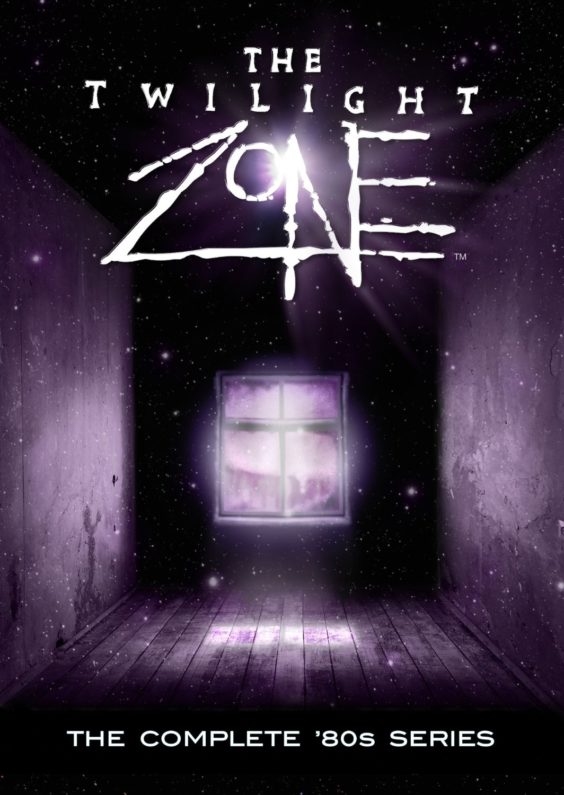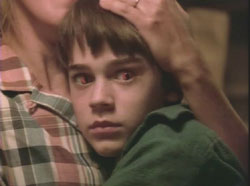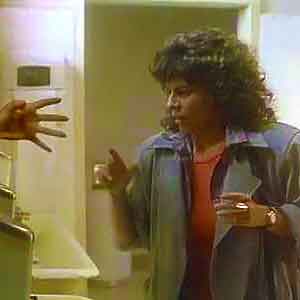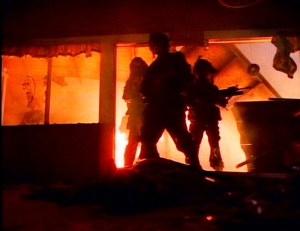2005 marked the release of what are in my view two of the most vital DVD collections on the scene. Sadly, though, I’m betting most horror fans missed picking up seasons one through three of CBS’s NEW TWILIGHT ZONE, available in two multi-DVD sets courtesy of Image Entertainment.
You’re forgiven if you don’t know about this TWILIGHT ZONE at all: it was broadcast in the latter half of the eighties, and, despite initially high ratings, ultimately got lost in the horror anthology craze that included TALES FROM THE DARKSIDE, THE HITCHHIKER, AMAZING STORIES, THE NEW ALFRED HITCHCOCK PRESENTS, REALLY WEIRD TALES, MONSTERS and RAY BRADBURY PRESENTS, even though it was easily the best of the bunch. For that matter, I believe this TWILIGHT ZONE far outshines the series’ latest incarnation, the ho-hum Showtime program with Forrest Whitaker (although I won’t make the same claim about the original Rod Serling Twilight Zone, which remains the apotheosis of anthology TV).
Why was THE NEW TWILIGHT ZONE so good? Simple: executive producer Phil DeGuere (who died in early 2005, just as the TZ season one DVD set was about to go on sale) was given a substantial budget for each episode and hired top flight talent, including writers like Harlan Ellison (who served as creative consultant for much of the first season), David Gerrold, George R.R. Martin and Rockne S. O’Bannon, along with directors like Wes Craven (who did what is arguably his finest post-NIGHTMARE ON ELM STREET work on the seven TZ segments he helmed), William Friedkin, Joe Dante, Robert Downey Sr., Martha Coolidge and Jim McBride. While extremely uneven, as most anthology programs are (the original TZ is certainly no exception), the series’ unwavering commitment to quality was evident throughout. As TZ’s executive story consultant Alan Brennert commented at the time: “There’s a real feeling that we’re doing something on television that no one else is doing.”
Unfortunately, it seems there’s an unwritten law, particularly prevalent during the eighties, stating that any TV program this special simply will not last very long, and indeed TZ barely made it through three seasons. Season one, which premiered on September 27, 1985 and ended on April 11, 1986, is the pinnacle of the series; season two, which ran from fall 1986 to Spring of ’87, wasn’t quite as good, while season three, which stunk up TV screens in ‘88-‘89, is best left unseen.
A particularly noteworthy element of all three seasons was the eye-popping opening sequence (below). Utilizing then state of the art animation and CGI, it remains a profoundly effective piece of work, starting with a nighttime landscape that turns into a globe through which freaky images flitter–a doll’s face, an African warrior mask, an atomic blast—and concluding with Rod Serling appearing in a nitrate swirl. Scored by the Grateful Dead, with Jerry Garcia doing a wicked acoustic rendition of the original TWILIGHT ZONE score, it’s a small triumph of disquiet. The narration by the gravelly voiced Charles Aidman is another plus, delivering just the right combination of ominous foreboding and soulful introspection.
**The TWILIGHT ZONE SOUNDTRACK**
One of the show’s most unique features—a feature that to my knowledge remains unique—is its format, at least in the first and part of the second season: each episode ran an hour and included two, sometimes three segments running anywhere from ten to fifty minutes each. In this way each scenario was allowed to play out at its own pace, without the cuts and/or padding required to fit it into a prescribed running time.
I’ll confess I didn’t fully appreciate this superb program when it was originally broadcast Friday nights at 8 PM. I was a kid back then, and, embarrassingly, lavished far more attention on Steven Spielberg’s (none too) AMAZING STORIES. Of course, Spielberg’s program was aimed at a kiddie demographic while TZ was definitely adult fare—and anyway, the AMAZING STORIES episodes I caught have long since faded from memory while the TZs I last viewed twenty years ago have stayed with me. Foremost among the latter are the Wes Craven directed “A Little Peace and Quiet”, about a woman (Melinda Dillon) who learns, to her ultimate peril, how to get everyone to “shut up”, leading to a final image that has all-but seared itself into my mind; “Wordplay”, in which a man (Robert Kline) finds the English language changing on him unexpectedly; “Children’s Zoo”, about a zoo where kids lock up their parents; “To See the Invisible Man”, about a man in a future society where everyone pretends he’s invisible; and the mind blowing “Nightcrawlers”, directed by William Friedkin from a story by Robert R. McCammon, which is arguably the highlight of the series, an incredibly intense, mayhem packed number involving a deranged Vietnam vet with unsettling supernatural powers.
Viewing the six-DVD season one set, I was introduced to a number of powerful episodes I missed the first time around. They include “Shadow Man”, a haunting tale of a boy and his encounter with the eponymous critter, which features bravura visuals courtesy of the one-and-only Joe Dante; the touching “Message from Charity”, in which a modern-day college kid finds himself in telepathic contact with a girl in Puritan New England; the trippy “Misfortune Cookie”, about a slimeball (Elliot Gould) who gets his just desserts at a mysterious Chinese restaurant; and “Shadow Play”, which examines what happens when a death row inmate (Peter Coyote) proclaims that everything going on around him is a dream.
Yes, there are some clunkers: “Teacher’s Aide” is a real bummer, about a put upon teacher (Adrienne Barbeau) zapped by a ray from a gargoyle statue that turns her into a tough chick; so is “Opening Day”, which tries, and fails, to create an atmosphere of hallucinatory dread in its story of a macho dude who kills his girlfriend’s hubbie and then somehow becomes him; likewise the dreadful “A Day in Beaumont”, the directorial debut of executive producer Philip DeGuere, who clumsily attempts to pay homage to fifties B-movies. The latter segment was unfortunately part of the premiere season’s final episode, closing things out on a decidedly inauspicious note.
Ratings wise, the show was a winner initially, nabbing in excess of thirty shares with its first few episodes. It was, ironically enough, after episode four, which featured the brilliant-by-any-standard “Nightcrawlers”, that viewership began to decline. It seems the segment in question, which one CBS executive branded the most intense half-hour ever broadcast on network television, was just too much for American TV watchers during the era of THE COSBY SHOW and CAGNEY & LACEY. For that matter, the entire program, eighties fashions and hair styles aside, was far ahead of its time in terms of sheer intensity. Another blow was the mid-season departure of Harlan Ellison as creative consultant, who quit when network censors axed his holiday episode “Nackles” (as detailed in the February ‘87 issue of The Twilight Zone Magazine, which also includes the script of the episode in question).
Network executives showed their faith in the series by moving its second season from Friday at 8 PM to a far less desirable time slot: Saturday at 10 PM, a.k.a. “The Ghetto”. The budget was also decreased and a last-minute decision made to slash the running time to a half hour, forcing the filmmakers to hastily cut their already shot segments. There are some great episodes herein, though, most notably “The After Hours” and “The Toys of Caliban”, seriously freaky inversions on the classic TZ episodes “After Hours” and “It’s a Good Life”. Other noteworthy segments include “The Card”, in which a spendthrift is given a special credit card that carries very grave consequences for missing payments; “Nightsong”, about a woman DJ who plays a record by her dead lover, who in turn mysteriously reappears; “A Saucer of Loneliness”, adapted from a Theodore Sturgeon story about a lonely woman’s encounter with a flying saucer; and “Shelter Skelter” in which Joe Montegna finds himself trapped in a fallout shelter in the wake of what seems like an all-out nuclear attack. Lesser episodes include “The World Next Door” a terminally uninvolving affair about an inventor who discovers a parallel world, and “The Once and Future King”, a by-the-numbers account of an Elvis impersonator who travels back in time to meet the real E.
Still, as erratic as season two was, its worst episodes are far superior to anything in season three, which was in fact a new NEW TWILIGHT ZONE–or, as it’s become known, TZ3. In a prime example of executive assholery at its most virulent, CBS cancelled the show after its second season and then brought it back a year later with a new creative team (including executive producer Mark Shelmerdine and story editor J. Michael Straczynski) laboring under half the budget and a tenth of the ambition of TZ’s previous incarnation. As if that weren’t enough, plans were hatched to recut all the previous episodes and rebroadcast them as part of this New-New TZ, but poor ratings thankfully put an end to that travesty-in-the-wings.
Mashup of Twilight Zone Openings
About the best I can say for TZ3 is that it wisely retained the brilliant opening sequence described above, and, unlike the previous series, was at least consistent—consistently boring and clichéd! It features a few almost-good episodes, like “Memories”, about a past-life regression therapist who somehow causes everyone in the world to remember their past lives; it’s marred, alas, by a half-baked narrative arc that fails to effectively build on the premise. Another in the almost-good category is “Room 2426”, which despite a lame third act features an effective performance by Dean Stockwell as a man imprisoned in a future world for thought crimes. The Harlan Ellison scripted “Crazy as a Soup Sandwich” is a witty take on the age-old idea of selling one’s soul to the Devil that’s tarnished by tacky lighting and crummy special effects. Of course, those are complaints one can make about all TZ3’s episodes, which uniformly suffer from low rent production values and predictable narratives. CBS pulled the plug on the show in 1989; I’d call it a mercy killing.
I don’t think I’m overreaching when I say the demise of THE NEW TWILIGHT ZONE marked the end of an era. The anthology programs that co-existed with TZ all went belly up around the same time it did, if not before (AMAZING STORIES only lasted a couple seasons, THE NEW ALFRED HITCHCOCK PRESENTS just one and even the long running TALES FROM THE DARKSIDE gave up the ghost at the end of the decade), while the much loved Twilight Zone Magazine closed its doors at the end of 1988.
A wise man (filmmaker Alexander Paine, as interviewed in the ’04 documentary Z CHANNEL: A MAGNIFICENT OBSESSION) has stated that you never know when you’re living in a golden age. That was certainly true in this case, although now, with the magic of DVD, we at least have a chance to relive it.




